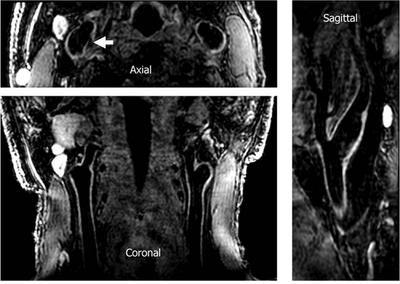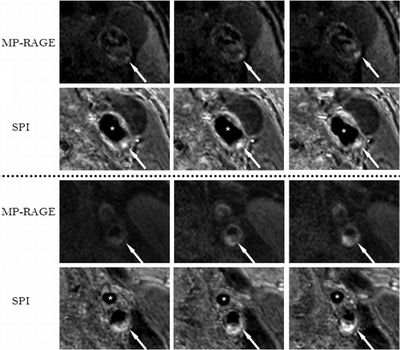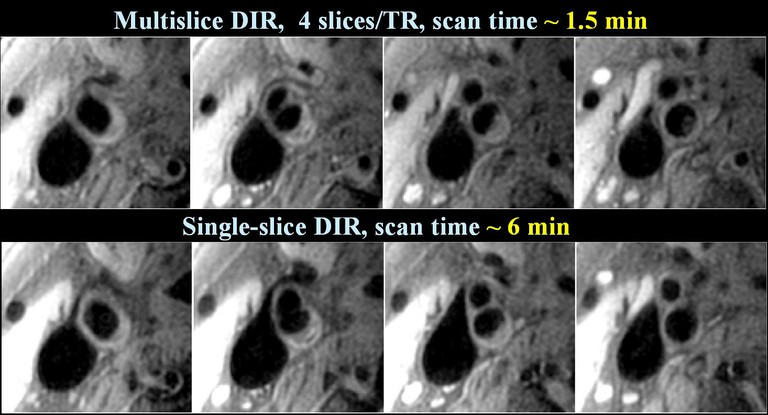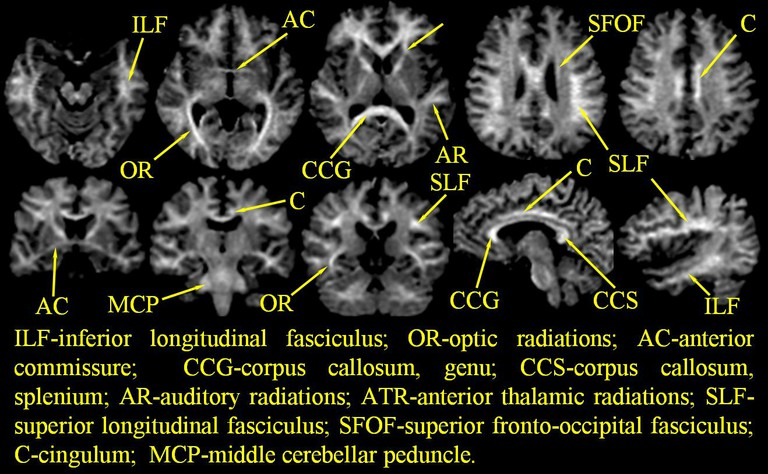Imaging Physics

Imaging Physics
The Imaging Physics group develops novel high-resolution magnetic resonance imaging protocols and technology to accurately identify and characterize the underlying features of vessel clots that cause ischemic stroke and heart disease.
Recent Developments
Fast Isotropic 3D black blood MRI
3D Motion Sensitized Driven Equilibrium prepared Rapid Gradient Echo (3D-MERGE) allows isotropic (0.7 x 0.7 x 0.7 mm) black-blood MRI of the vessel wall within a 2 minute scan time with large coverage (upto 16 cm) of the carotid artery.

3D isotropic high resolution (0.7×0.7×0.7mm3) carotid artery image acquired with 3D MERGE sequence. Arrow on axial reformat shows a small piece of calcification. Vessel wall boundaries are clearly visible on all reformats.
Blood suppression for intraplaque hemorrhage imaging
Slab-selective Phase-sensitive inversion recovery improves on the MP-RAGE sequence by providing higher contrast for hemorrhage and improved blood-suppression by using a phase sensitive reconstruction.

Elimination of plaque mimicking flow artifacts
Motion Sensitized Driven Equilibrium preparation suppresses blood based on phase dispersion of magnetization among moving spins. Unlike inflow suppression and double-inversion recovery techniques that are flow dependent, MSDE can eliminate plaque mimicking artifacts in regions of complicated flow such as the carotid bifurcation.

Flow suppression capability of different BB imaging techniques in the carotid bifurcation: (a) Inflow Suppression, (b) DIR, (c) Multi-slice DIR, and (d) MSDE. The residual flow signal is eliminated by MSDE but visible for other techniques (arrows). *, internal carotid lumen; **, external carotid lumen.
Quadruple Inversion-recovery black-blood imaging

• Quadruple Inversion-recovery (QIR)
A novel blood suppression method, which is highly insensitive to a T1 of blood and is intended specifically for black-blood contrast-enhanced cardiovascular imaging.
Multislice double inversion recovery black-blood imaging

• Multi-slice Double Inversion-Recovery (DIR)
A time-efficient modification of the DIR blood suppression method can result in an up to eight-fold decrease in scan time.
Cross-relaxation imaging.

• Cross-relaxation imaging
A new parametric imaging modality that visualizes fiber tracts and quantitatively characterizes brain tissue offers promising new applications for neurological research which will focus on pathologies resulting in focal and systemic brain damage, such as multiple sclerosis, stroke, and other neurodegenerative, inflammatory, and autoimmune disorders.